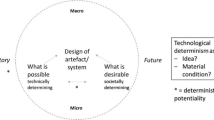Abstract
Human-centered design is of growing importance for professional designers and in the past two decades a series of techniques for designers to develop understanding of and empathy with a diversity of users has been developed within this field. In the second half of the twentieth century, intended users were involved late in the design process, i.e. during the testing of products or prototypes. More recently, the user is involved in the early phases, when the direction is set. Users have rich local contextual knowledge and can work together with professional designers. Although these techniques are now entering mainstream design education at the university level, they have not yet reached Design and Technology Education in primary and secondary schools. Most teachers do not yet provide opportunities for pupils to conduct research to uncover the needs, wishes, and experiences of specific user groups. However, this understanding of users belongs in D&T education, because artifacts have a dual nature: a physical and an intentional nature. In this paper we describe a Contextmapping method for pupils (aged 9–12 years) and illustrate this with a design project. The assignment for the pupils was to “design a playground in which children and elderly people are active together” in which the pupils developed an understanding of elderly people through Contextmapping.








Similar content being viewed by others
References
Boeijen, G., Kneepkens, B., & Thijssen, J. (2011). Natuurkunde en techniek voor de basisschool. Een domeinbeschrijving als resultaat van een cultuurpedagogische disussie. Arnhem: CITO. (Physics and Technology in Primary Education; A description of the field as a result of a pedagogical discussion).
Bras-Klapwijk, R. M. (2005). Technology as social design; new study and career paths for young people, summary. The Hague: Netherlands Study Centre for Technology Trends.
Druin, A. (2002). The role of children in the design of new technology. Behaviour & Information Technology, 21(1), 1–25.
Eijkelhof, H. M. C., & Krüger, J. (2009). Improving the quality of innovative science teaching materials. ESERA 2009 Conference Istanbul.
Haven, K. (2007). Story proof. The science behind the startling power of story. Westport: Libraries Unlimited.
Hill, A. M. (1998). Problem solving in real-life contexts: An alternative for design in technology education. International Journal of Technology and Design Education, 8(3), 203–220.
Jarvis, T., & Pell, A. (2004). Primary teachers’ changing attitudes and cognition during a two-year science in-service programme and their effect on pupils. International Journal of Science Education, 26(19), 1787–1811.
Kimbell, R. (1994). Tasks in technology: An analysis of their purposes and effects. International Journal of Design and Technology Education, 4, 241–256.
Klapwijk, R., & Rommes, E. (2009). Career orientation of secondary school students (m/f) in the Netherlands. International Journal of Technology and Design Education, 19, 403–418.
Koski, M. I., Klapwijk, R., & De Vries, M. (2011). Connecting domains in concept-context learning: A model to analyse education situations. Design and Technology Education: An International Journal, 16(3), 50–61.
Kroes, P. (2002). Design methodology and the nature of technical artefacts. Design Studies, 23, 287–302.
Kroes, P., & Meijers, A. (2006). The dual nature of technical artefacts. Studies in the History and Philosophy of Science, 37, 1–4.
Liem, A., & Sanders, E. B. (2013). Human-centred design workshops in collaborative strategic design projects: An educational and professional comparison. Design and Technology Education: An International Journal, 18(1), 72–86.
Maguire, M. (2001). Methods to support Human Centered Design. International Journal of Human-Computer Studies, 55, 587–634.
Ministry of Education, Culture and Science (MECW). (2004). Deltaplan Béta/Techniek. Den Haag: OCW.
Ministry of Education, Culture and Science (MECW) (2006). Core objectives primary education. Den Haag: OCW. (Appendix to the Kerndoelenboekje 2006).
Murphy, C., Neil, P., & Beggs, J. (2007). Primary science teacher confidence revisited: Ten years on. Educational Research, 49(4), 415–430.
Nicholl, B., Hosking, I., Elton, E., Lee, Y., Bell, J., & Clarkson, P. (2012). Inclusive design in the Key Stage 3 classroom: An investigation of user-centred design principles in design and technology. International Journal of Technology and Design Education,. doi:10.1007/s10798-012-9221-9.
Qualifications and Curriculum Authority (QCA). 2007. Design and technology. Programme for key stage 3 and attainment target. www.qca.org.uk/curriculum.
Read, J., Gregory, P., MacFarlane, S., McManus, B., Gray, P., & Patel, R. (2002). An investigation of participatory design with children: informant, balanced and facilitated design. Interaction design and Children pp 53–64.
Sleeswijk Visser, F., Stappers, P. J., van der Lugt, R., & Sanders, E. B. N. (2005). Contextmapping: Experiences from practice. CoDesign, 1(2), 119–149.
Van Doorn, F., Stappers, P. J., & Gielen, M. (2013). Design research by proxy: Using children as researchers to gain contextual knowledge about user experience. CHI Conference Paris.
Van Graft, M., Klein Tank, M., & Beker, T. (2014). Wetenschap & technologie in het basis- en speciaal onderwijs, Richtinggevend leerplankader bij het leergebied Oriëntatie op jezelf en de wereld, SLO (Dutch Framework for Teaching Science and Technology in Primary Schools).
Acknowledgments
We would like to thank the “Wetenschapsknooppunt Delft” of the TU Delft for facilitating this project. This research is part of the ProFit project, which is funded by the European Union, under the Interreg IVB North West Europe program.
Author information
Authors and Affiliations
Corresponding author
Rights and permissions
About this article
Cite this article
Klapwijk, R., Van Doorn, F. Contextmapping in primary design and technology education: a fruitful method to develop empathy for and insight in user needs. Int J Technol Des Educ 25, 151–167 (2015). https://doi.org/10.1007/s10798-014-9279-7
Accepted:
Published:
Issue Date:
DOI: https://doi.org/10.1007/s10798-014-9279-7




